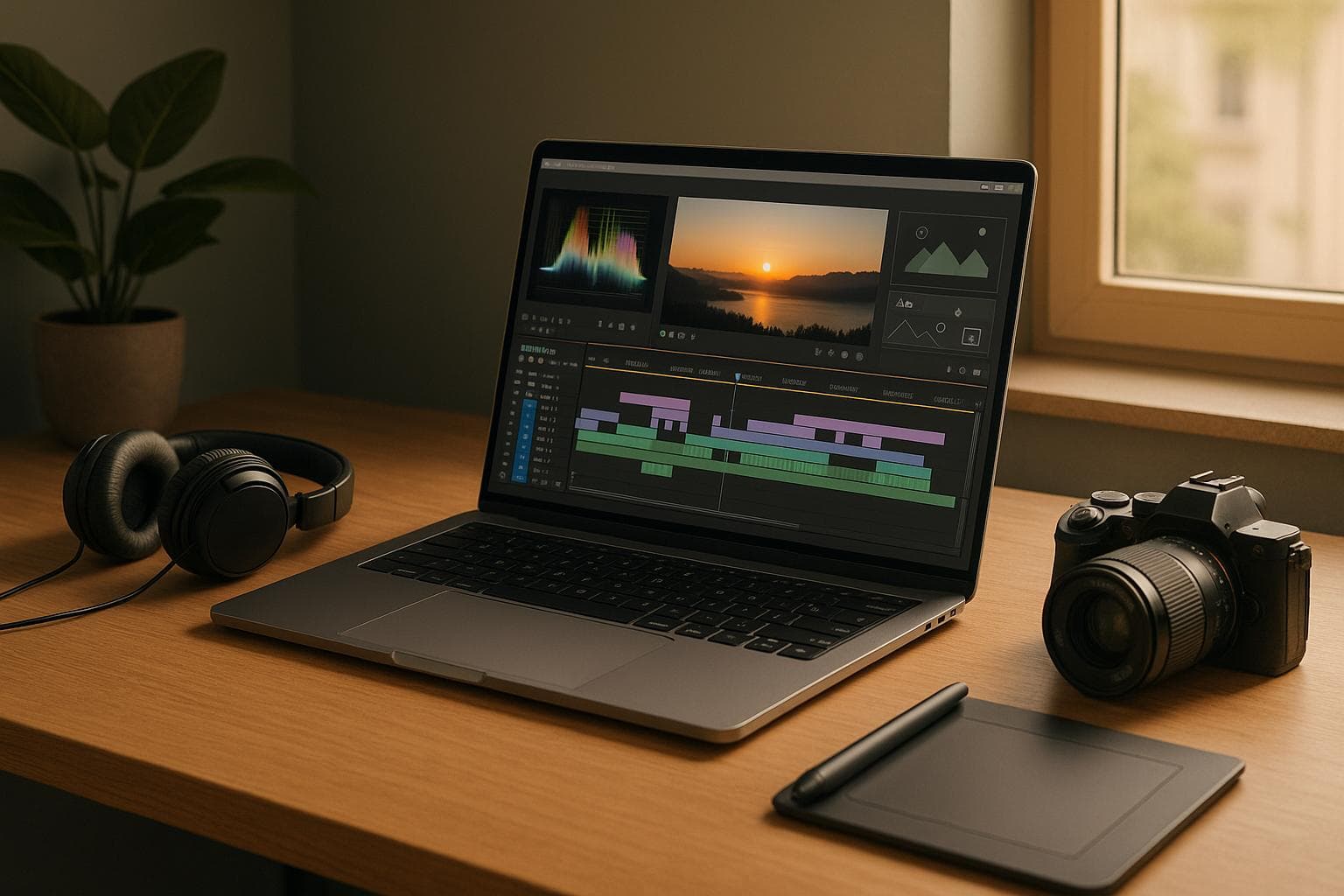
Best Offline Media Editors: 2025 Roundup
Offline media editors are essential in 2025 for creators who need privacy, speed, and reliability. Whether you're editing videos, audio, or images, offline tools let you work without an internet connection, ensuring better performance and security.
Key Benefits of Offline Editors:
- Privacy: All files are processed locally, reducing the risk of data breaches.
- Performance: Faster editing by using your computer’s CPU, GPU, and memory directly.
- Cost-Effective: Many offer one-time purchases, avoiding recurring subscription fees.
- AI-Powered Tools: Advanced features like color grading, noise reduction, and automated edits now work offline.
Top Picks for 2025:
- Video Editing: Pimosa Media Studio (affordable, beginner-friendly) and DaVinci Resolve Studio (professional-grade tools).
- Audio Editing: Audacity 4.0 (free, powerful updates), Pimosa Media Studio (all-in-one), and Ocenaudio (simple, no-frills).
- Image Editing: Affinity Photo 3 (professional features), PhotoDirector Essential (AI tools), and Pimosa Media Studio (basic, budget-friendly).
Quick Comparison:
| Category | Best Tools | Key Features | Pricing |
|---|---|---|---|
| Video Editing | Pimosa Media Studio, DaVinci Resolve Studio | Batch processing, frame-by-frame cropping, advanced color grading, VFX integration | $19-$300 |
| Audio Editing | Audacity 4.0, Pimosa, Ocenaudio | Real-time spectral editing, AI enhancements, waveform visualization, metadata editing | Free-$29 |
| Image Editing | Affinity Photo 3, PhotoDirector, Pimosa | Non-destructive editing, AI sky replacement, batch processing, basic compression/conversion | Free-$55 |
Offline editors are evolving with on-device AI and local collaboration tools, making them faster, smarter, and more secure. Whether you're a beginner or a professional, there’s an offline editor tailored to your workflow.
4 Best Video Editing Software for PC in 2025!
What to Look for in Offline Media Editors
Choosing the right offline media editor involves weighing several important factors that can influence your editing experience and overall workflow. The best tools strike a balance between offering powerful features and being easy to navigate, enabling you to create professional-quality content without unnecessary complications.
Performance and Ease of Use
When it comes to performance, your computer's CPU plays a huge role. Generally, more cores mean faster rendering, but there’s a point where adding more cores shows diminishing returns. For most users, a well-balanced CPU is key.
Memory is another critical factor. While 8GB of RAM is the bare minimum, especially for basic tasks, 16GB or more is highly recommended if you're working with 4K video or complex projects. Similarly, storage speed matters - a solid-state drive (SSD) significantly outperforms traditional hard drives, particularly when handling large files or intricate timelines with multiple layers and clips. This is especially true for high-resolution footage and multi-layered edits.
An intuitive interface is just as important as raw performance. Look for editors that make essential tools - like trimming, cropping, and compressing - easily accessible without burying them in endless menus. Built-in media players or preview options can also save time by letting you review your work without switching between applications.
Beyond hardware and usability, compatibility with your workflow is just as crucial.
File Format and Workflow Support
Your chosen editor should support the formats you commonly work with, including modern video, audio, and image codecs that reduce processing strain. This ensures smoother editing and fewer compatibility headaches.
Batch processing is another feature to look for, especially if you deal with multiple files. This allows you to apply edits, adjustments, or conversions to entire folders at once, saving you hours of repetitive work.
All-in-one solutions that combine video, audio, and image editing tools can also simplify your workflow. Instead of juggling multiple programs and learning different interfaces, these integrated tools let you handle everything in one place.
"Single app that do everything related to image and video editing and that too at flat cost so no need to worry about the subscription." - Mehul Fanawala, RevOps Consultant for B2B SaaS
Before making a final decision, take advantage of free trials. Testing the software firsthand ensures it aligns with your specific needs and editing style.
In addition to functionality, offline editors also offer strong privacy benefits.
Privacy and Offline Security
One of the standout advantages of offline editors is enhanced privacy. Since all media files are processed locally on your device, there’s no need to upload sensitive content to the internet. This greatly reduces the risk of data breaches and minimizes exposure to external threats.
Another benefit is the control you maintain over your files. You decide where they’re stored and who has access to them, which lowers the chances of unauthorized access. Offline editors are particularly useful for handling sensitive data - like personal information or confidential documents - because they don’t rely on an internet connection.
Best Offline Video Editors for 2025
The video editing tools of 2025 bring robust offline options for creators of all skill levels. These editors provide dependable performance without requiring an internet connection. Below, we dive into two standout options that excel in offline video editing.
Pimosa Media Studio

Pimosa Media Studio is a versatile desktop tool that handles video, audio, and image editing with ease. It’s designed for anyone seeking professional results through a straightforward, user-friendly interface.
This software offers features like video compression, conversion, resizing, trimming, and speed adjustments. Its batch processing feature is a major time-saver, allowing you to edit multiple files at once. Plus, the built-in video player lets you preview edits instantly.
"Previously, I was using another app for my video compression and I didn't like the UI or the experience. Pimosa goes above and beyond my expectations. It's now my go-to for compressing, converting and so much more. So glad I found this app!" - Xentar, Private photographer
One of Pimosa’s standout features is its drag-and-drop interface, which makes it approachable for beginners while still satisfying experienced editors. For creators focusing on social media, the frame-by-frame cropping tool is a game-changer. As one user shared:
"Leave the tools side, I love the built-in editor where I can crop my landscape videos frame by frame and upload it on TikTok." - Zhang Yong
Pimosa’s pricing is flexible: a one-year license costs $19, lifetime personal access is $29, and extended lifetime use for two devices is $49. A 3-day free trial is also available, giving users a chance to explore its features before committing.
DaVinci Resolve Studio
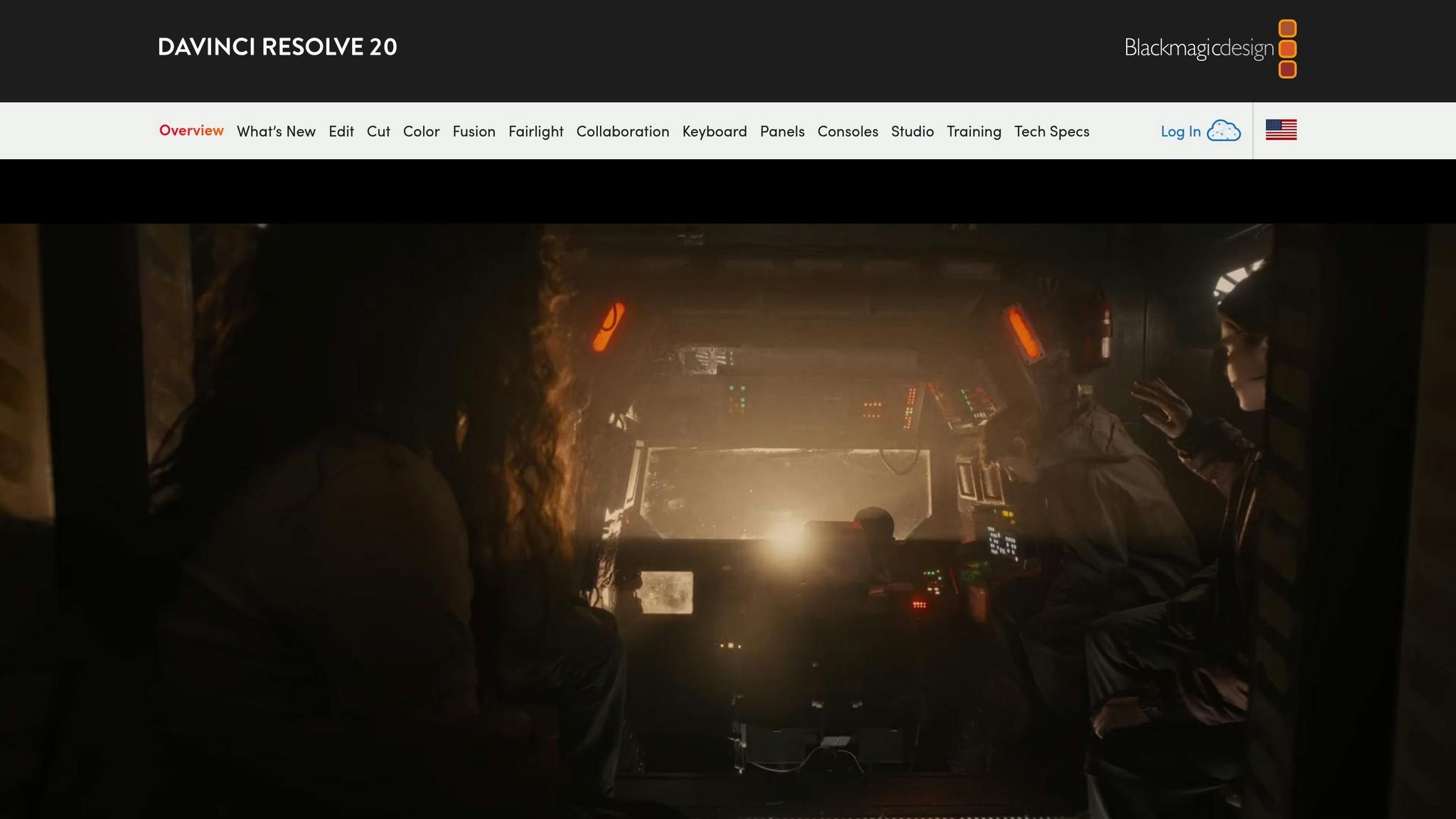
For those seeking advanced editing capabilities, DaVinci Resolve Studio is a top-tier choice. This professional-grade offline editor offers specialized interfaces for every aspect of post-production, including cutting, effects, audio mastering with its Fairlight interface, and advanced color grading through its Color interface.
Its color grading tools are particularly impressive, often surpassing the capabilities of many competing video editors and even some photo editing software. Beyond that, DaVinci Resolve Studio integrates tools like Fusion, a free VFX application, making it a comprehensive solution for complex workflows.
Like other offline editors, DaVinci Resolve Studio ensures smooth and secure performance without interruptions. While the free version is feature-rich, the Studio edition unlocks additional professional tools for $300. The platform also boasts an active online community, which is incredibly helpful for new users navigating its advanced features.
These two editors highlight the range of offline video editing tools available in 2025. Whether you prefer Pimosa Media Studio’s simplicity and all-in-one functionality or DaVinci Resolve Studio’s professional-grade features, there’s a solution to meet every creative need - all while working offline with confidence.
Best Offline Audio Editing Tools
In 2025, offline audio editing tools have become indispensable for creators like podcasters, musicians, and sound designers who prioritize security, reliability, and high-quality output. These tools allow users to work without depending on an internet connection, offering peace of mind and ensuring accessibility no matter the circumstances. Whether you're crafting a podcast, mixing tracks, or fine-tuning audio for a project, offline editors provide the dependable functionality you need.
Pimosa Media Studio for Audio
Pimosa Media Studio isn’t just about video editing; it also packs a robust set of audio tools into one convenient package. From converting and merging files to trimming and editing metadata, this software handles essential tasks with ease.
What sets Pimosa apart is its waveform video creation tool, which automatically generates visual waveforms from audio files. This is a game-changer for podcasters and musicians aiming to create eye-catching content for platforms like Instagram or TikTok. The built-in audio player further simplifies the process by allowing instant playback and preview during editing.
For those managing multiple files, Pimosa’s batch processing feature is a lifesaver. Whether you’re trimming, merging, or converting several audio files at once, this functionality saves time and effort. The metadata editor also helps users organize their audio libraries with precision. Combined with its offline video and image editing capabilities, Pimosa provides a comprehensive media editing toolkit. Pricing starts at $19 for a one-year license, with lifetime access available for $29, making it an affordable option for creators who need an all-in-one solution.
Audacity 4.0
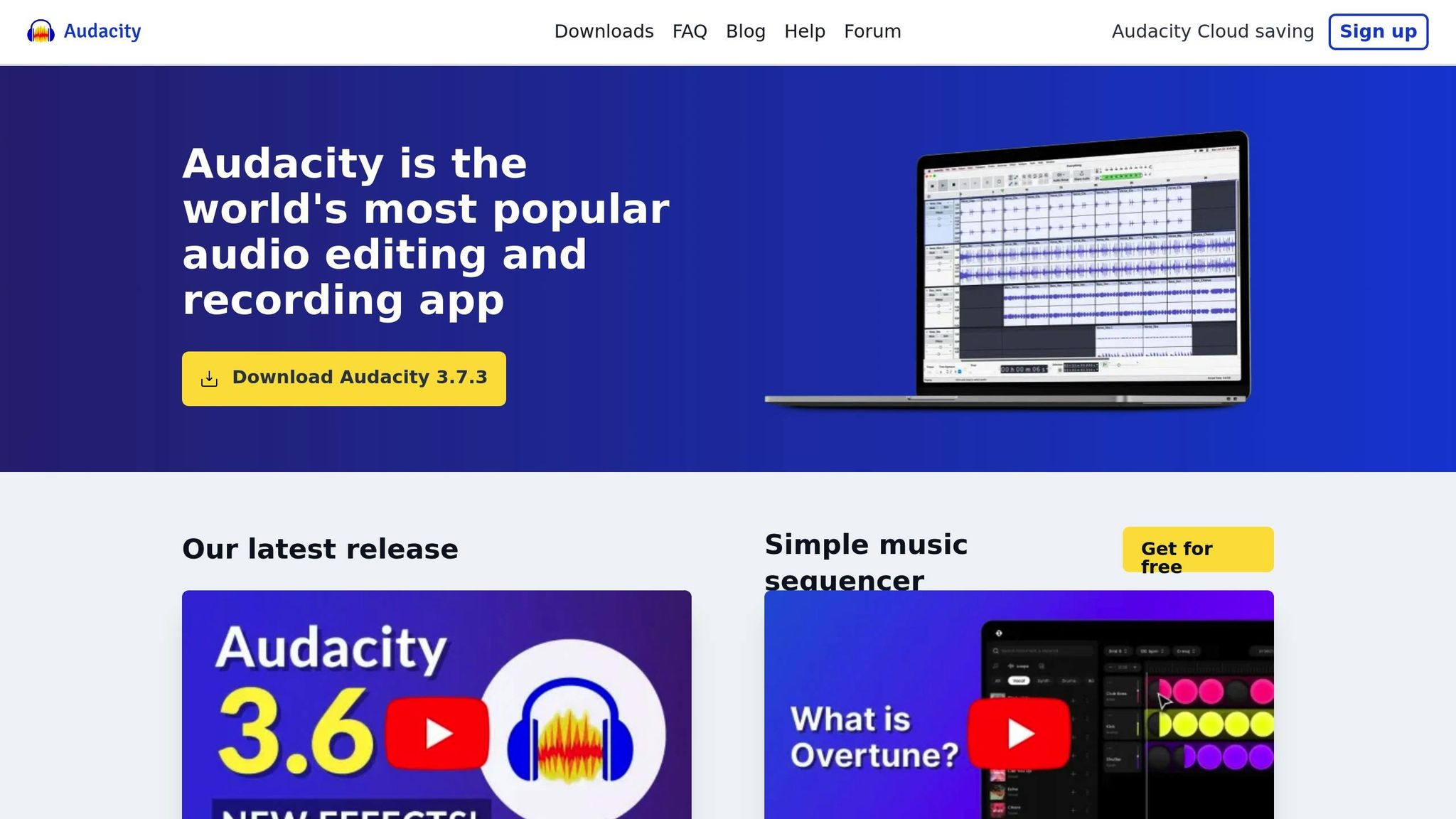
Audacity hit a major milestone on May 28, 2025, with the release of Audacity 4.0, which introduced significant upgrades in both usability and features.
"Audacity is the world's most popular free software for recording and editing audio. So if you're producing music, a podcast, or just playing around with audio, Audacity is for you." - Audacity Team
This latest version includes real-time spectral editing, making noise reduction and audio restoration faster and more precise. AI-powered effects have been added to automatically enhance audio quality, keeping up with the growing trend of intelligent audio processing. The update also brings expanded plugin support, including VST3 and Nyquist plugins, giving advanced users even more production flexibility.
Audacity 4.0 has been rebuilt using Qt6, resulting in better performance and stability. It supports a wide range of audio formats like WAV, MP3, FLAC, and Ogg, and works seamlessly across Windows, macOS, and Linux. Its spectrogram view and Vamp analyzers offer in-depth audio analysis, while an upcoming asset manager feature promises to make organizing projects even easier.
Ocenaudio
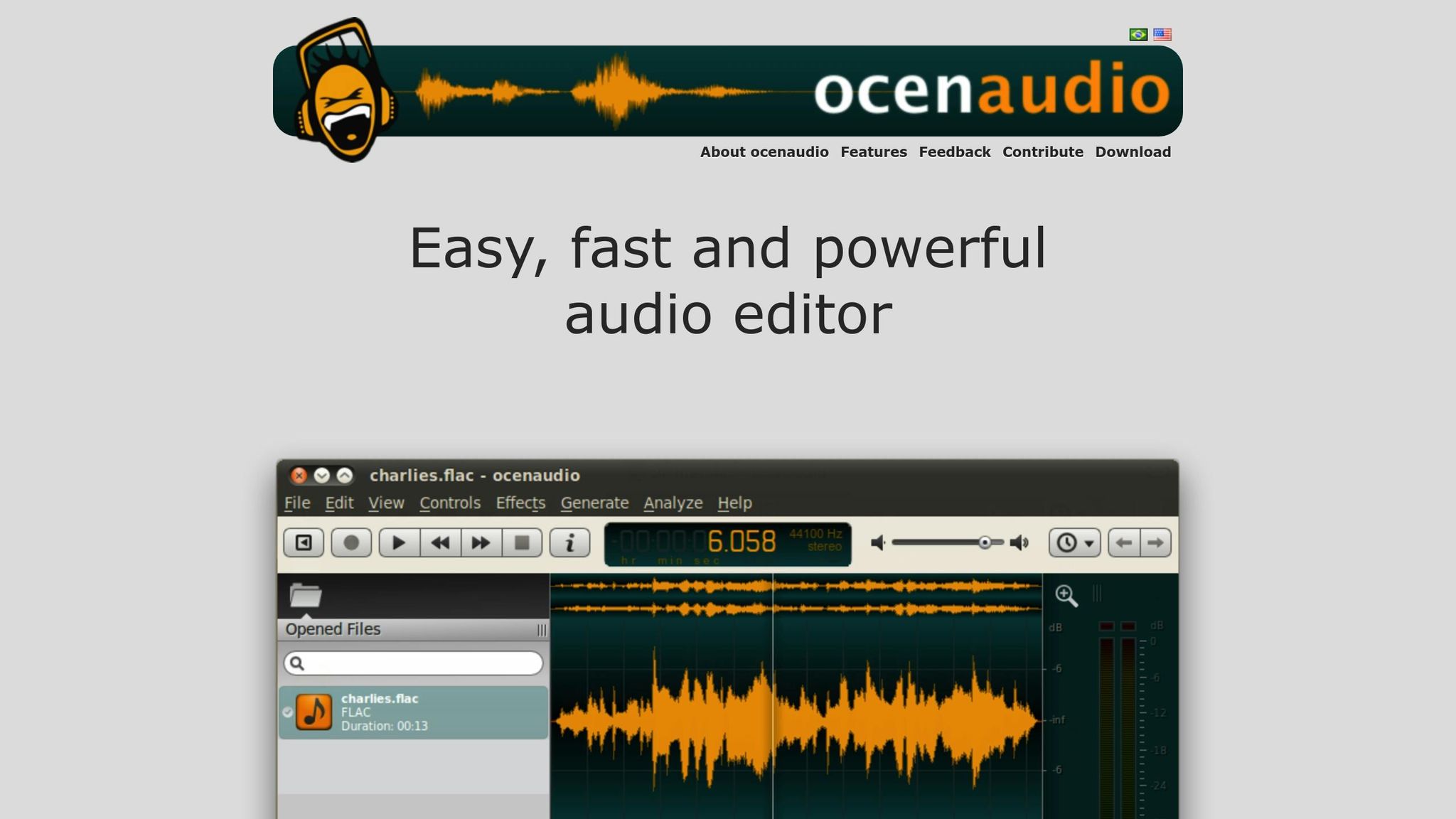
Ocenaudio has earned a reputation for its clean interface and straightforward functionality, making it a favorite for users who value simplicity. Rated 4/5 on Capterra for ease of use, this Brazilian-developed editor focuses on essential audio editing tasks without overcomplicating the process.
With detailed waveform visualization, Ocenaudio makes isolating and enhancing voice tracks a breeze. It also excels at removing background noise and improving vocal clarity. Its cross-platform compatibility ensures consistent performance on Windows, macOS, and Linux, making it a dependable choice for offline editing.
While it doesn’t boast the extensive plugin options of Audacity or the multi-functional capabilities of Pimosa, Ocenaudio’s focus on core editing features makes it perfect for users seeking a reliable, no-frills solution.
These three tools highlight the variety of offline audio editing options available in 2025. Whether you need a full-featured suite, advanced plugins, or a streamlined interface, there’s a tool to match your workflow and creative goals. Each of these editors ensures that offline media editing remains secure and efficient.
sbb-itb-60ba97a
Best Image Editors for Offline Use
In 2025, image editing continues to adapt to the needs of photographers, designers, and content creators who demand reliable tools. Offline image editors offer a secure and dependable way to work, ensuring your creative projects remain private and accessible without interruptions. Whether you’re fine-tuning portraits, fixing small flaws, or handling large photo batches, these tools provide the stability and features needed for professional results.
Here’s a closer look at three standout offline image editors, catering to a range of editing needs - from basic tweaks to advanced capabilities.
Pimosa Media Studio for Images
Pimosa Media Studio is a versatile tool designed for essential image editing tasks. It handles everything from compression and conversion to resizing and basic adjustments like cropping, flipping, and rotating. One of its most useful features is batch processing, which allows you to compress or convert entire folders of images at once - perfect for speeding up workflows when prepping photos for online use.
The software also includes an image viewer for instant previews of your edits, and its compression tool reduces file sizes while maintaining quality. Working offline ensures fast, uninterrupted editing while keeping your files secure. In April 2025, Softpedia reviewed Pimosa 1.2.4.0, praising its modern interface and straightforward menu for accessing key features. While it doesn’t offer advanced tools like color correction, it covers the basics effectively. Pricing starts at $19 for a one-year license or $29 for lifetime access, making it a budget-friendly choice for simple editing needs.
Affinity Photo 3
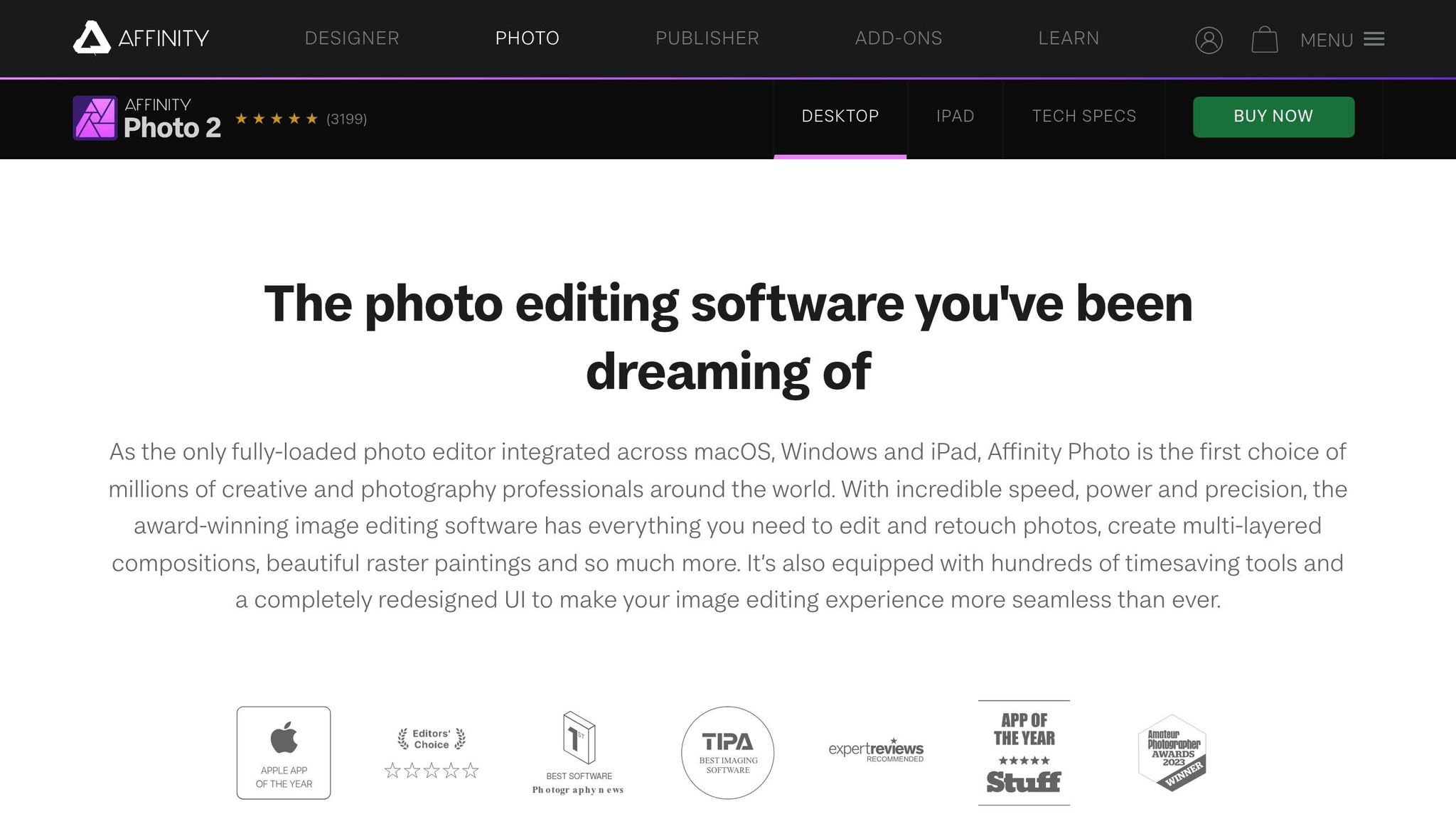
For those seeking more advanced tools, Affinity Photo 3 is a top pick among professionals. This software offers robust features like non-destructive editing, focus stacking, and HDR merging, allowing users to achieve intricate retouching and high-quality enhancements. Its offline functionality ensures smooth editing without delays, while also safeguarding sensitive projects by keeping them entirely on your device.
PhotoDirector Essential
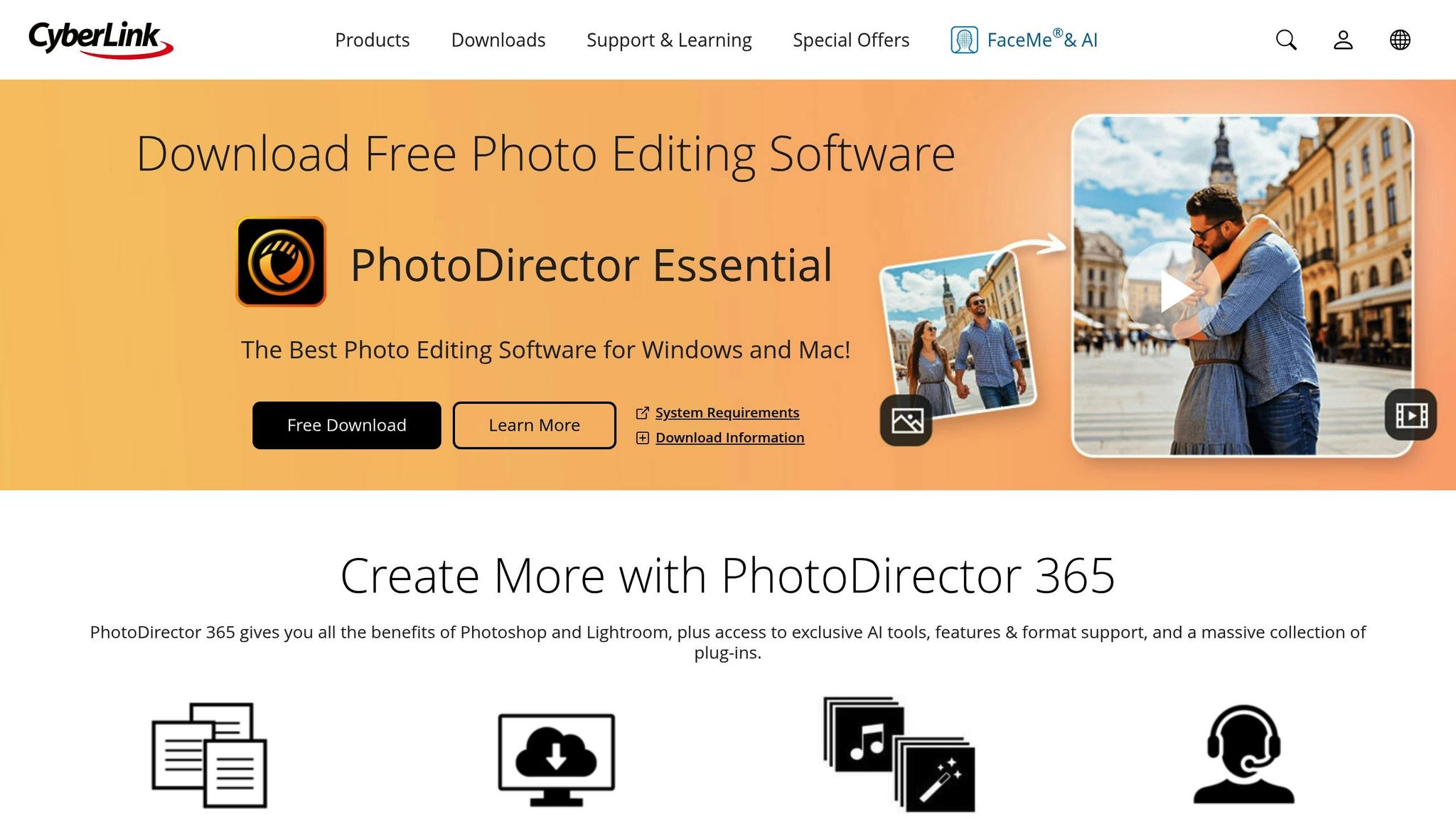
PhotoDirector Essential combines AI-powered tools with offline editing to simplify complex workflows. Key features include smart object removal, RAW file processing, panorama stitching, and AI sky replacement. It also supports batch processing, enabling you to apply edits across large photo collections efficiently. With a 4.3/5 rating on G2, PhotoDirector Essential strikes a balance between advanced features and ease of use, all while ensuring the privacy and security benefits of offline editing.
These three tools showcase the range of offline image editing options available in 2025. Whether you’re looking for basic file management, professional-grade retouching, or AI-assisted enhancements, there’s a solution to match your needs - all without relying on an internet connection.
New Trends in Offline Media Editing
The world of offline media editing is undergoing a transformation, driven by advancements in technology that bring speed, security, and collaboration to the forefront. Two key trends are shaping this evolution: on-device AI capabilities and local network collaboration tools. Together, they're revolutionizing how creators work - without the need for an internet connection.
On-Device AI Features
AI isn't just a cloud-based phenomenon anymore. By 2025, tasks like color matching, object recognition, and automated editing are being handled directly on computers and mobile devices. This shift is changing the game for editors.
The numbers tell the story. The on-device AI market was valued at $16.66 billion in 2023 and is projected to skyrocket to $118.12 billion by 2031, with a growth rate of 27.95% annually. Apple is leading the way with its Neural Engine, which powers advanced AI models directly on its devices. Their iOS 18 rollout in 2025 introduced Apple Intelligence, featuring tools like Genmoji, Image Playground, Smart Search in Photos, and Writing Tools, showcasing the potential of on-device AI.
For media editors, this means new tools that simplify and enhance workflows. AI now automates tasks that once took hours. For example, it can upscale video to higher resolutions, restore old footage, and improve audio clarity - all processed locally on your device. Mobile devices have also leveled up, with AI-driven features like video stabilization and audio enhancements making high-quality editing possible right from your smartphone. Beyond convenience, on-device AI offers significant privacy and security benefits, as data never leaves your device. It also delivers instant responsiveness and offline functionality, ensuring your projects are secure and accessible anytime.
These advancements align perfectly with the strengths of offline editing, making it more powerful than ever.
Local Network Project Sharing
Collaboration is another area where offline editing is breaking new ground. Local network sharing now allows teams to work together in real-time without relying on an internet connection.
The need for better collaboration tools is clear. Around 30% of remote workers still struggle with effective teamwork, and 62% of managers believe traditional meetings hinder team cohesion. On the flip side, teams that communicate well experience a 14% boost in productivity and a 23% rise in profitability. In fact, 80% of workers say their ability to perform depends on how well their colleagues communicate. Clearly, seamless collaboration is no longer optional - it’s essential.
Modern local network solutions address these challenges by enabling real-time editing, instant feedback, and secure file sharing within a closed environment. This eliminates delays caused by file transfers and version control issues while keeping your data private and secure. Unlike cloud-based tools, local networks ensure that projects remain accessible even during internet outages.
"Practices and structures that may have worked well with simple teams of people who were all in one location and knew one another will probably lead to failure when teams grow more complex…Yesterday's teams…didn't require the same amount of members, diversity, long-distance cooperation, or expertise that teams now need to solve global business challenges." – Lynda Gratton and Tamara J. Erickson, Organizational Experts
Looking ahead, local network tools are set to become even more advanced, with features like real-time version control and seamless integration with productivity software. AI and machine learning are also being incorporated to automate tasks, enhance security, and provide predictive insights.
These innovations highlight the growing importance of offline editing. With the rise of on-device AI and smarter collaboration tools, creators now have more control, flexibility, and privacy than ever before. Offline editing in 2025 isn’t just keeping up - it’s setting new standards for what’s possible in media creation.
How to Choose the Right Offline Media Editor
Selecting the right offline media editor can elevate your creative workflow by matching your specific needs with the right features. The best editor seamlessly integrates into your process, supports your hardware, and aligns with your creative goals.
Start by identifying your primary focus. If video editing is your main task, look for software that includes multi-camera support, chroma keying, and advanced color correction. For audio projects, prioritize tools equipped with sound correction, audio mixing capabilities, and options for adding music or voiceovers. Image editors will benefit from features like color correction, filters, and tools to add text and graphics.
Your skill level should also guide your choice. Beginners should opt for software with an intuitive interface and accessible tutorials. On the other hand, professionals may need advanced features, extensive customization options, and compatibility with other professional tools. As one expert puts it, effective video editing combines technical expertise with the art of storytelling. Offline editors ensure a smooth, secure experience for users at all levels.
Performance, compatibility, and privacy are critical factors to consider. Make sure the editor supports the file formats you use most often. Check hardware requirements carefully, as some software includes compatibility checks to flag potential issues with your system.
Privacy and security are more important than ever. With 69% of online users encountering privacy or security issues in 2023 and 39% of businesses reporting data breaches from online collaborative tools, offline editing provides a safer alternative. Choose software that processes files locally, uses strong encryption, and offers regular security updates. This local approach ensures your projects remain private and secure.
Speed and workflow integration also play a huge role in your decision. A good editor should prioritize speed, freeing you to focus on the creative aspects of your work. Whether you prefer a streamlined, guided process or complete control over every detail, pick software that complements your style.
For creators seeking a versatile option, Pimosa Media Studio is worth considering. It offers reliable offline editing for video, audio, and images. With local file processing, batch processing capabilities, and built-in players, it’s designed for efficiency and privacy. At $29 for lifetime access, it’s a budget-friendly choice for creators who need dependable offline tools.
Ultimately, the best way to find the right editor is to test your top picks with actual projects. The ideal software won’t just meet your technical needs - it will enhance your workflow and let your creativity shine.
FAQs
What are the benefits of using offline media editing tools in 2025?
Offline media editors in 2025 bring some clear advantages that set them apart from online tools. For starters, they offer faster performance and greater reliability. By using your computer's hardware directly, these tools handle large files and complex projects with ease - no internet connection required.
Another standout feature is their focus on security and privacy. With offline tools, your work stays on your device, eliminating the need to upload sensitive files to the cloud. This reduces the chances of data breaches or unauthorized access, giving you peace of mind.
Lastly, offline editors ensure smooth, uninterrupted workflows. They’re perfect for users in areas where internet access is limited or unstable. Whether you're tackling a professional project or pursuing a creative hobby, these tools give you the flexibility and dependability to work efficiently, no matter the circumstances.
What features and pricing make Pimosa Media Studio stand out among offline media editors?
Pimosa Media Studio: Your Go-To Offline Editing Tool
Pimosa Media Studio is an all-in-one offline editing software tailored for video, audio, and image editing. It comes packed with essential tools like compression, conversion, resizing, and merging, all wrapped up in a clean, intuitive interface. Whether you're working on macOS or Windows, this software ensures smooth performance and even supports batch processing, making it a practical choice for both casual users and professionals.
What sets Pimosa Media Studio apart? Its pricing. For a one-time payment of $29, you get access to a feature-rich platform without the hassle of recurring subscription fees. Plus, its offline capabilities mean you can rely on it anytime, anywhere - no internet connection required. It's a solid, budget-friendly option for anyone serious about media editing.
What hardware do I need for the best performance with offline media editing tools?
To ensure offline media editors perform at their best, it's crucial to have hardware that can handle the demands of editing software and large media files. Here's what you should aim for:
- Processor: Opt for a multi-core CPU like the Intel Core i7 or AMD Ryzen 7. These processors are designed to handle complex tasks efficiently, ensuring smooth performance.
- Memory (RAM): A minimum of 16 GB of RAM is necessary, but if you're working on larger projects or multitasking, 32 GB will provide extra headroom.
- Storage: Go for an SSD with at least 1 TB of space. SSDs not only speed up file access but also make your editing workflow much smoother.
- Graphics Card: A dedicated GPU, such as the NVIDIA GeForce RTX or AMD Radeon RX series, is essential for rendering and managing high-resolution media without lag.
- Display: A 4K monitor is highly recommended for precise editing and accurate color grading, giving you a clearer and more detailed view of your work.
Make sure your system also has proper cooling to manage the heat generated during intensive tasks and a reliable power supply to support these high-performance components. With these upgrades, you'll be set for a seamless and efficient editing experience, even when tackling demanding projects.